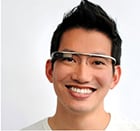In these environments, designs could be built without the constraints of light optics or the laws of physics that have meant such imaginative products could never have worked in reality.
The traditional problem faced by head mounted displays had been the inability to combine overlaid graphics, text, video or imagery whilst allowing an individual to maintain awareness of his or her immediate surroundings.
However, now two new product concepts, which are discussed below, have suggested they have a solution that allows their informational displays to be see-through allowing people to maintain points of reference with their environment.
These devices have also seemingly overcome the second notable problem that has thus far proved a barrier to entering consumer markets. Whereas previous attempts have had to encompass the technology needed to create the device, which is often bulky, heavy and uncomfortable.
Google Glass
 Google X recently unveiled a viral video piece that shows off a prototype concept of a compact, mobile, heads-up visual display unit (VDU) that’s incorporated into a set of glasses named Project Glass.
Google X recently unveiled a viral video piece that shows off a prototype concept of a compact, mobile, heads-up visual display unit (VDU) that’s incorporated into a set of glasses named Project Glass.
For anyone that missed it, here’s the link to the Google Glass concept video.
The glasses, which carry a headband-style design, are set to incorporate 14 core services, including weather updates, location services and map data, reminders, social networking and more. One of the central ideas behind Project Glass is the creation of a product or device that allows for the incorporation and integration of functionality and features found on smartphones that can be directly overlaid within our field of vision.
Google’s video suggests a number of examples where the device could provide useful information such as providing the weather outlook, traffic updates, directions, and facilitating social interactions.
In order for this product to work Google is tasked with blending the technology with science as well as taking into account ergonomic, technological and aesthetic considerations in order to appeal to the wider population.
Would individuals adopt such a device? Whilst hands-free mobile headsets exist, the closest like product we can find that has consumer adoption, they certainly don’t draw anywhere near the same numbers seen with iPhone sales.
Digilens Dataview
 The Digilens Dataview augmented reality display is a lightweight, full colour head-mounted device that was styled and fashioned by Renfrew Group International, a UK based product design company. The product was built for US client SBG Labs, who design and manufacture the optical holographic display technology which the device incorporates.
The Digilens Dataview augmented reality display is a lightweight, full colour head-mounted device that was styled and fashioned by Renfrew Group International, a UK based product design company. The product was built for US client SBG Labs, who design and manufacture the optical holographic display technology which the device incorporates.
The design shown above is just one type of this holographic headset; there are plenty of additional styles designed for use in different situations. Just one of the proposed uses for this device includes athletes being able to display biometric information during work outs.
 SBG Labs are currently working with both the aviation and military sectors on developing the future solutions in display technologies, which will further enhance the immersive user experience whilst reducing the weight and ergonomic impact for the user.
SBG Labs are currently working with both the aviation and military sectors on developing the future solutions in display technologies, which will further enhance the immersive user experience whilst reducing the weight and ergonomic impact for the user.
You can watch their technical presentation, which reveals the optical mechanics behind the device if you’re interested in finding out more.
With the renewed interest in this Minority Report-esque product coming with the announcement of Google Glass, combined with emerging consumer trends that have evolved highlighting the use of smart phone technology, the reality of a consumer ready product coming to market seems closer than ever before.

















